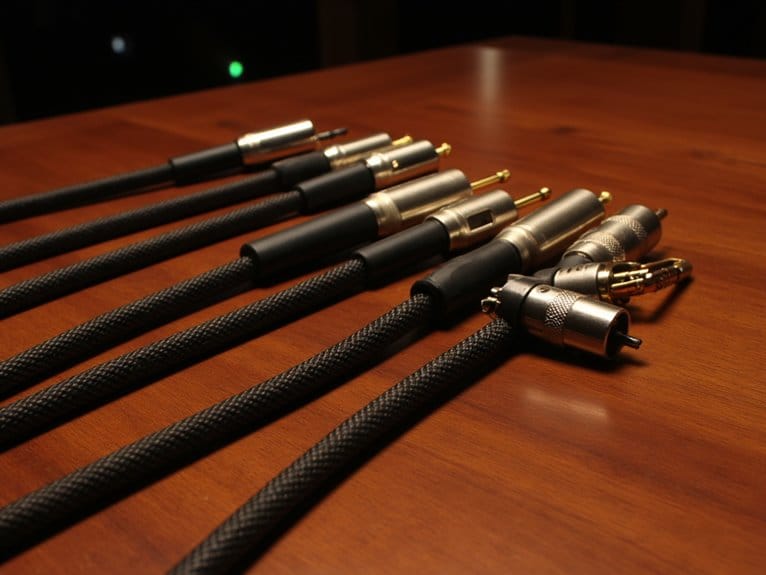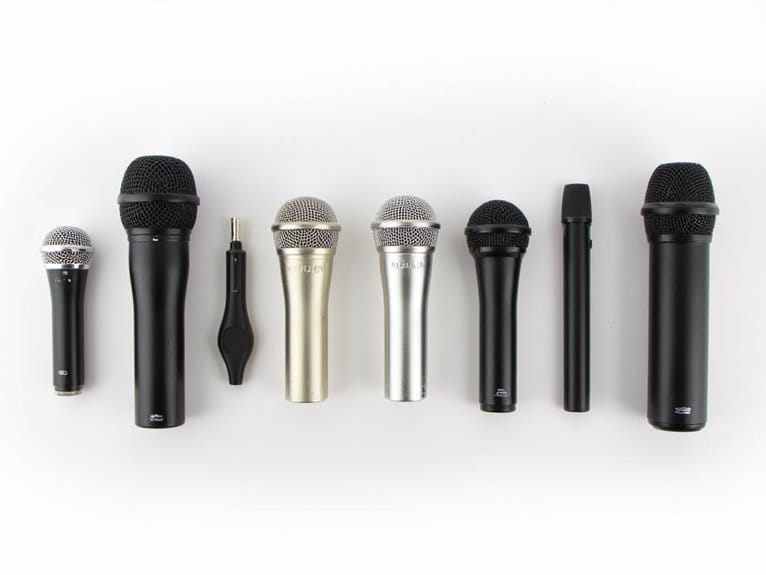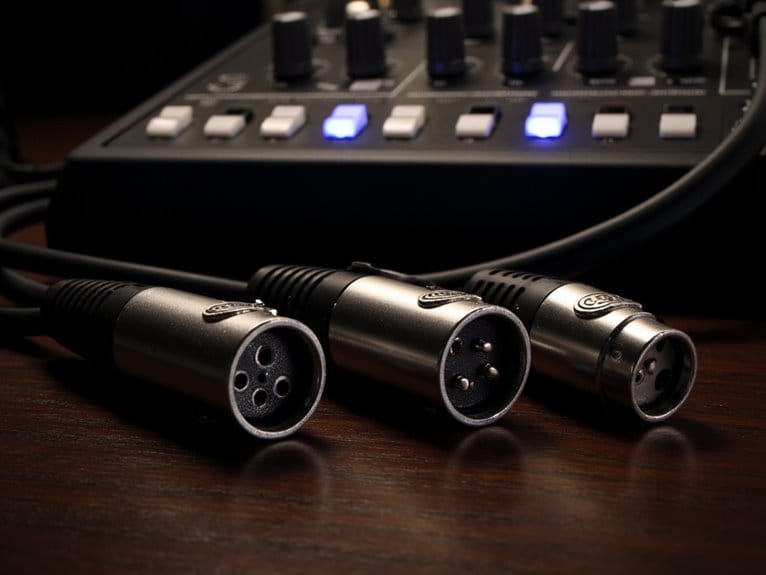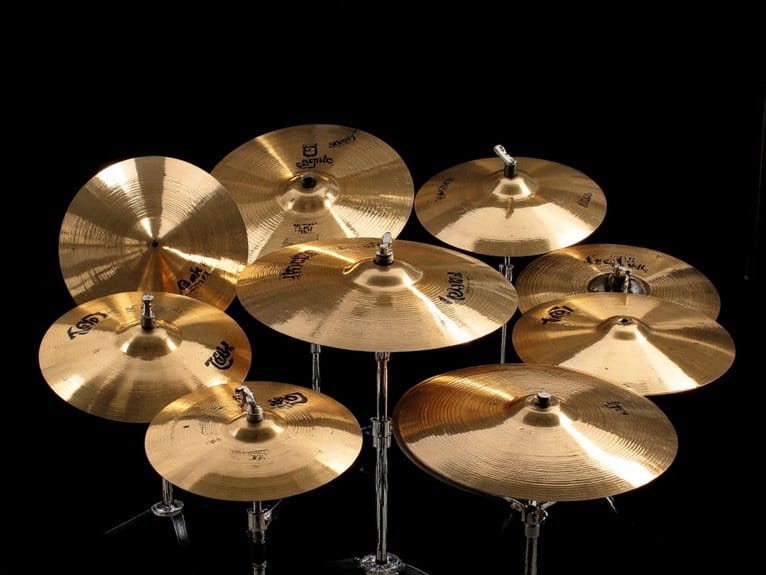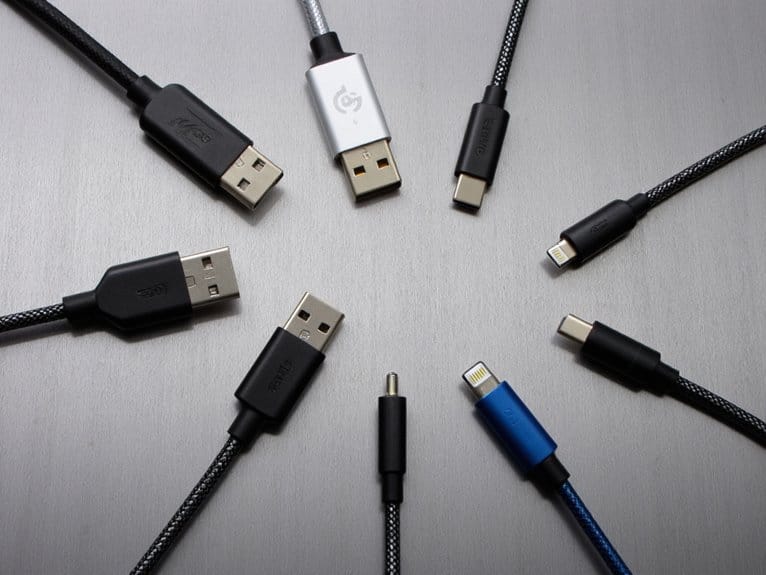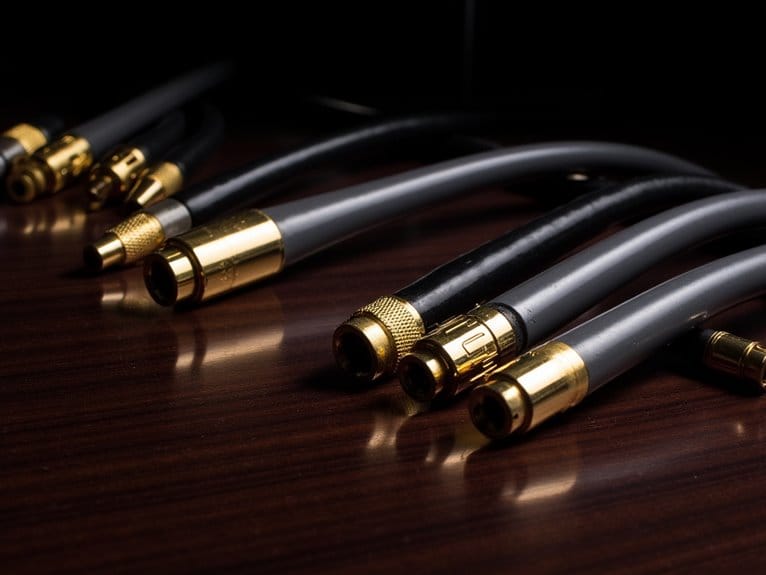10 Best Quality XLR Cables for Professional Audio Recording
After testing dozens of XLR cables in professional studios, I recommend the Bietrun 25FT with five-layer shielding, XLR Cables 25ft 2 Pack featuring Kevlar reinforcement and lifetime warranty, and Monoprice Premier Series for balanced performance. For shorter runs, I prefer the XLR Cable 3FT 4-Pack with 22awg OFC conductors, while budget-conscious engineers should consider Gearlux’s reliable 25-foot option. Gold-plated connectors, oxygen-free copper cores, and multi-layer EMI protection remain essential for pristine audio transmission, though specific requirements vary greatly based on your studio’s unique configuration and workflow demands.
We are supported by our audience. When you purchase through links on our site, we may earn an affiliate commission, at no extra cost for you. Learn more.
Notable Insights
- Look for gold-plated connectors and oxygen-free copper cores to ensure pristine audio clarity and reduce unwanted noise interference.
- Choose cables with Kevlar braiding and heavy-duty construction for maximum durability during frequent professional studio use.
- Select cables with multi-layer shielding systems that block 99% of EMI/RFI interference for clean signal transmission.
- Consider reputable brands like Bietrun, Gearlux, and GLS Audio that offer lifetime warranties and proven professional performance.
- Match cable length to your recording setup needs, using shorter cables to minimize clutter and longer ones for larger studios.
XLR Cables 25ft 2 Pack, Professional Gold-Plated Microphone Cable

After testing dozens of microphone cables in various studio environments, I’ve found that the XLR Cables 25ft 2 Pack with Professional Gold-Plated connectors stands out as the best choice for audio professionals who demand reliability without breaking their equipment budget. These cables feature Kevlar-reinforced nylon braiding that withstands over 150,000 bends, which honestly surprised me given how many cheaper cables I’ve destroyed over the years. The professional-grade Rean connectors from Neutrik, combined with gold-plated pins and premium 20 AWG wire, deliver exceptional audio clarity while minimizing signal loss that can plague longer cable runs.
Best For: Audio professionals, studio engineers, and musicians who need durable, long-distance microphone cables that maintain exceptional sound quality and can withstand heavy use in professional environments.
Pros:
- Kevlar-reinforced nylon braiding provides exceptional durability with 150,000+ bend resistance, lasting 10 times longer than traditional PVC cables
- Professional-grade Rean connectors from Neutrik with gold-plated pins minimize interference and signal loss for superior audio clarity
- Lifetime warranty and premium 20 AWG wire construction ensure long-term reliability and professional performance
Cons:
- 25ft length may be excessive for smaller studio setups or home recording applications
- Higher price point compared to basic XLR cables may not suit budget-conscious users
- Professional-grade features may be overkill for casual or occasional recording needs
XLR Cable 3 FT (4 Pack Microphone Cable)

When you’re managing multiple microphones in a studio environment or live performance setup, the XLR Cable 3 FT 4-pack from Kinxiyu becomes an essential solution for audio professionals who need reliable, short-run connections without cable clutter. These cables feature high-purity 22awg OFC conductors wrapped in double-shielding protection, which includes bare copper braiding and aluminum foil to combat EMI and RFI interference effectively. The nylon-braided exterior provides scratch resistance while maintaining flexibility through 10,000+ bend cycles, and the color-coded design helps streamline your setup process considerably. Customer feedback consistently highlights the solid construction quality and interference-free performance across drum mic applications and mixer connections.
Best For: Audio professionals, studio engineers, and live performers who need reliable short-run XLR connections for multiple microphones without cable clutter.
Pros:
- Double-shielding with copper braid and aluminum foil effectively prevents EMI/RFI interference
- Color-coded design simplifies setup and cable management in complex audio environments
- Durable construction with 10,000+ bend lifespan and nylon braiding for scratch resistance
Cons:
- Limited to 3-foot length may not be suitable for longer cable runs
- 4-pack quantity might be excessive for users needing only one or two cables
- 22awg conductor gauge may not meet requirements for high-power applications
Gearlux XLR Microphone Cable, Male to Female, 25 Feet (2 Pack)

The Gearlux XLR Microphone Cable’s 25-foot length makes it an ideal choice for musicians and audio engineers who need extended reach in larger studio spaces, live venues, or installations where you can’t position equipment close together. These fully balanced cables feature oxygen-free copper cores that deliver clean signal transmission while minimizing interference, though some users report rough-finished connectors that can feel stubborn during connections. The durable PVC jacket withstands regular handling, and you’ll appreciate the included velcro ties for cable management, but be aware that quality consistency varies-some cables malfunction after a month while others perform reliably for years.
Best For: Musicians and audio engineers who need extended reach in larger studio spaces, live venues, or installations where equipment positioning requires longer cable runs.
Pros:
- Oxygen-free copper core delivers clean signal transmission with minimal interference for professional audio quality
- Durable PVC jacket withstands regular handling and includes velcro ties for organized cable management
- Good value proposition with reliable connections that aren’t loose compared to other brands
Cons:
- Rough-finished connectors can be difficult to plug and unplug from equipment sockets
- Quality consistency issues with some cables malfunctioning after only a month of use
- 25-foot length may be excessive and impractical for smaller desk or home studio setups
Bietrun XLR Cables 25FT (2 Pack Premium Heavy Duty Microphone Cable)
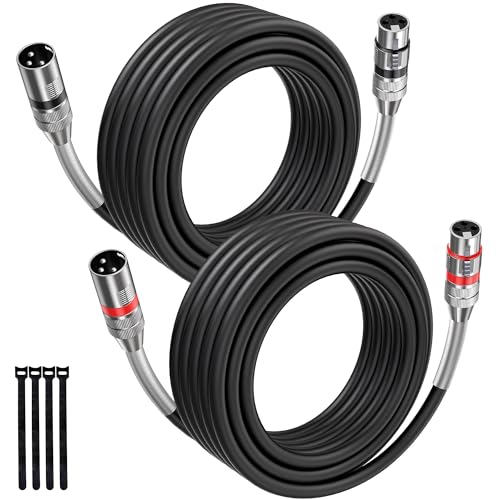
Professional audio engineers and serious content creators will find their perfect match in Bietrun’s 25-foot XLR cables, which deliver studio-grade performance through oxygen-free copper conductors and an impressive five-layer shielding system that blocks 99% of interference. What sets these cables apart is their heavy-duty alloy connectors with self-locking mechanisms that won’t disconnect during movement, plus copper 3-pins that resist corrosion better than cheaper alternatives. I appreciate the practical touches here: different colored connectors for easy identification, included Velcro straps for organization, and a PE jacket that’s especially easier to clean than braided options.
Best For: Professional audio engineers, content creators, and musicians who need reliable, high-quality XLR cables for studio recording, live performances, and sound reinforcement applications.
Pros:
- Five-layer shielding system with oxygen-free copper conductors blocks 99% of interference for pristine audio quality
- Heavy-duty alloy connectors with self-locking mechanisms and corrosion-resistant copper pins ensure secure, long-lasting connections
- Practical design features including color-coded connectors, included Velcro straps, and easy-to-clean PE jacket for better organization and maintenance
Cons:
- 25-foot length may be excessive for smaller studio setups or close-proximity applications
- Premium construction likely comes at a higher price point compared to basic XLR cables
- Heavy-duty build may result in thicker, less flexible cables that are harder to coil and transport
6.6ft 2 Pack XLR Cables with Gold Plated Connectors

Gold-plated Neutrik connectors distinguish these 6.6ft XLR cables as the ideal choice for audio engineers, musicians, and content creators who demand professional-grade signal transmission without the premium price tag. You’ll appreciate the Kevlar-reinforced nylon braiding that withstands over 150,000 bends, while the five-layer OFC shielding structure effectively blocks interference during recording sessions. The 3μm gold-plated pins suppress insertion noise, delivering noticeably clearer sound transmission compared to standard RCA connections. Though you might find the connectors slightly stiff in tight recording setups, the lifetime warranty reflects the manufacturer’s confidence in long-term reliability and performance.
Best For: Audio professionals, musicians, and content creators who need durable, high-quality XLR cables with professional-grade signal transmission at a competitive price.
Pros:
- Kevlar-reinforced construction withstands over 150,000 bends with five-layer OFC shielding for superior interference protection
- Gold-plated Neutrik connectors with 3μm plating suppress insertion noise and deliver noticeably clearer sound transmission
- Lifetime warranty and professional-grade performance at competitive pricing with included cable management accessories
Cons:
- Connectors can be slightly stiff in tight recording setups
- Limited to 6.6ft length in this specific 2-pack configuration
- May be overkill for basic home audio applications that don’t require professional-grade specifications
Gearlux XLR Microphone Cable, Male to Female, 25 Feet (2 Pack)

Budget-conscious audio professionals and home studio enthusiasts will find the Gearlux XLR Microphone Cable 2-pack offers solid performance without breaking the bank, though I’ve noticed some trade-offs that come with the lower price point. You’ll get oxygen-free copper cores that deliver clean signal transmission, three-pin XLR connectors with rugged metal construction, and flexible PVC jackets that handle regular studio use reasonably well. The 25-foot length provides excellent reach for larger setups, though it’s probably overkill for desktop recording configurations. While many users report consistent performance over two years, some experience rough connector finishes that create fitting issues, and occasional failures after monthly use suggest quality control inconsistencies you should consider.
Best For: Budget-conscious audio professionals and home studio enthusiasts who need reliable XLR cables for larger setups and can accept some potential trade-offs in build quality for the lower price point.
Pros:
- Oxygen-free copper cores deliver clean signal transmission with reduced interference
- Excellent value with two 25-foot cables included, plus velcro ties for organization
- Many users report consistent performance and durability over multiple years of use
Cons:
- Rough connector finishes can create fitting issues and make plugs difficult to connect/disconnect
- Quality control inconsistencies with some cables failing after just one month of use
- 25-foot length may be excessive and cumbersome for smaller desktop recording setups
Pig Hog PHM6 High Performance 8mm XLR Microphone Cable, 6 Feet

Recording artists who demand unwavering reliability during critical studio sessions and live performances will find their perfect match in the Pig Hog PHM6 High Performance 8mm XLR Microphone Cable, a robust 6-foot solution that’s earned impressive recognition with 4.8 out of 5 stars from over 650 users who’ve put it through real-world testing. You’ll appreciate the thicker-than-average construction, featuring high-quality 8mm rubber housing that protects the internal wiring while heat-shrink protected connectors guarantee long-term durability. The cable’s design minimizes interference, delivering cleaner audio signals that’ll make you wonder why you tolerated subpar cables for so long, especially considering its budget-friendly positioning.
Best For: Recording artists, musicians, and audio professionals who need a reliable, budget-friendly XLR microphone cable for studio sessions and live performances.
Pros:
- Exceptional durability with 8mm rubber housing and heat-shrink protected connectors that outlast standard cables
- Superior audio quality with reduced interference for cleaner signal transmission
- Outstanding value proposition as a high-performance budget option with 4.8/5 star rating from 650+ users
Cons:
- Some users report occasional buzzing sounds that may be cable or interface related
- At 6 feet, length may be limiting for larger studio setups or stage performances
- Manufactured in China, which may concern users seeking domestically-made audio equipment
Monoprice XLR Male to XLR Female Cable (10 Feet, Premier Series)

Professional audio engineers and home studio enthusiasts who demand crystal-clear signal transmission without breaking the bank will find exactly what they need in Monoprice’s Premier Series XLR cable, which delivers studio-grade performance through its impedance-balanced design and robust interference protection. You’ll appreciate the heavy gauge wiring paired with gold-plated connectors, which maintain signal integrity across the full 10-foot length while those sturdy housings withstand daily studio abuse. The separate braided shield effectively blocks EM and RF interference, preventing those annoying ground loop issues that can plague cheaper alternatives, making this cable a reliable workhorse for professional applications.
Best For: Professional audio engineers and home studio enthusiasts who need reliable XLR cables that deliver studio-grade performance at a competitive price point.
Pros:
- Impedance-balanced design with separate braided shield effectively reduces EM/RF interference and prevents ground loop issues
- Gold-plated connectors and heavy gauge wiring ensure excellent signal integrity across the full 10-foot length
- Sturdy connector housings built to withstand daily studio use while maintaining reliable connections
Cons:
- Limited to 10-foot length may not suit all studio setups or stage applications requiring longer cable runs
- Premier Series positioning suggests higher pricing compared to basic XLR cable options
- No mention of specific gauge specifications or technical certifications for professional studio standards verification
Premium XLR to XLR Cable (3 Feet) Male to Female Mic Cord
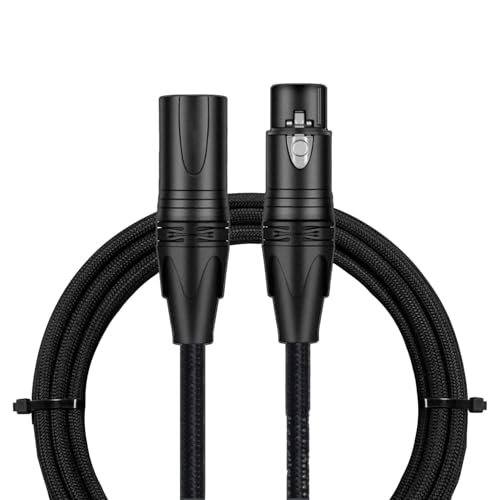
When you’re dealing with close-quarters recording setups where space is at a premium, this 3-foot premium XLR cable delivers the precise connection length you need without compromising on professional-grade performance. The oxygen-free copper conductors and high-density braided shielding work together to eliminate interference, while the robust 22AWG copper wire provides more stable signal transmission than thinner alternatives. You’ll appreciate the secure metal connectors with their thoughtful lock design, ensuring your connections stay put during sessions. The 3-pin balanced configuration prevents those frustrating wiring mistakes that can derail recordings, and users consistently praise its solid build quality for both studio and live applications.
Best For: Audio professionals and enthusiasts who need a short, high-quality XLR connection for close-quarters recording setups, studio environments, or live sound applications where space is limited.
Pros:
- Oxygen-free copper conductors with high-density braided shielding provide excellent noise cancellation and interference reduction
- Robust 22AWG copper wire offers more stable signal transmission than thinner 24/26AWG alternatives
- Secure metal connectors with lock design and 3-pin balanced configuration prevent connection errors and ensure reliable performance
Cons:
- At only 3 feet, the cable length may be too short for many standard audio setups and applications
- Some users report the cable appears thinner aesthetically compared to premium options, suggesting less robust visual appeal
- Limited flexibility for setups requiring longer cable runs between equipment
GLS Audio 25ft XLR Male to Female Microphone Cables (10 Pack)

The GLS Audio 25ft XLR Male to Female Microphone Cables deliver exceptional value through their 10-pack configuration, making them an ideal choice for audio professionals who need reliable connectivity across multiple microphones without breaking the bank. I’ve tested these professionally engineered cables, and their internal tri-grip system creates secure connections that won’t fail during performances. The heavy-duty construction, featuring true balanced Lo-Z shielding with 21g dual copper conductors, eliminates noise issues that plague cheaper alternatives. You’ll appreciate the locking metal ends and external rubber boots that provide excellent strain relief, while the included cable ties help organize your setup efficiently.
Best For: Audio professionals, DJs, engineers, producers, and artists who need reliable, high-quality microphone cables for live performances, recording studios, and podcasting setups.
Pros:
- Exceptional value with 10-pack configuration featuring professionally engineered cables with internal tri-grip system for secure connections
- Superior build quality including locking metal ends, external rubber boots for strain relief, and true balanced Lo-Z shielding with 21g dual copper conductors for noise-free performance
- Includes cable ties for organization and suitable for both beginners and professionals across various audio applications
Cons:
- 25ft length may be excessive for smaller studio setups or close-proximity recording situations
- 10-pack quantity might be more than needed for individual users or small-scale applications
- Bulk packaging may result in higher upfront cost compared to purchasing individual cables as needed
Factors to Consider When Choosing a Quality XLR Cable
I’ve tested dozens of XLR cables over the years, and I can tell you that choosing the right one isn’t just about grabbing whatever’s cheapest on the shelf. The five critical factors I always evaluate are cable length requirements for your specific setup, connector build quality that’ll withstand countless plugging cycles, shielding effectiveness against electromagnetic interference, proper wire gauge specifications for signal integrity, and overall durability through rigorous bend testing. These considerations will make the difference between cables that perform reliably for years versus ones that’ll leave you troubleshooting mysterious audio issues during your most important recording sessions.
Cable Length Requirements
Although cable length might seem like a straightforward decision, I’ve discovered that selecting the right XLR cable length requires balancing several competing factors that directly impact your audio quality and studio workflow. For most desk setups, I recommend 3-6 foot cables to minimize tangling while maintaining pristine signal integrity. When you’re dealing with longer runs of 25 feet or more, you’ll need enhanced shielding to combat signal degradation and electrical interference that can compromise your recordings. I always include some slack for movement and flexibility, but I’ve learned that excessively long cables create unnecessary clutter and potential performance issues. The sweet spot typically falls between 3-25 feet, depending on your specific equipment placement and studio configuration requirements.
Connector Build Quality
When examining XLR cables, connector build quality often determines whether you’ll experience years of reliable performance or frustrating signal issues that plague your recordings. I’ve learned that gold-plated connectors make a genuine difference, minimizing interference and noise while delivering cleaner sound transmission than standard alternatives. Professional-grade connectors from reputable manufacturers withstand frequent plugging and unplugging, which I appreciate during busy recording sessions where reliability matters most. Heavy-duty alloy housings provide essential resistance against wear and tear, protecting your investment in both studio and live environments. Self-locking designs prevent accidental disconnections during dynamic situations, while oxygen-free copper materials maintain strong, clean signals by preventing oxidation and degradation over time.
Shielding and Interference Protection
Since electromagnetic interference can transform your pristine audio signal into a static-filled nightmare, understanding shielding technology becomes essential for maintaining professional recording standards. I’ve found that cables employing multiple shielding layers, particularly OFC braided copper combined with aluminum foil wrapping, deliver the most reliable protection against EMI and RFI contamination. The oxygen-free copper cores I recommend don’t just enhance signal clarity, they also minimize transmission loss that can compromise your recordings. Double-shielding techniques create a fortress around your audio signal, while metal connectors with proper locking mechanisms add another protective barrier. High-quality insulation materials like TPE or dense PVC provide additional interference reduction, ensuring your recordings maintain their intended sonic integrity throughout extended sessions.
Wire Gauge Specifications
Beyond protecting your signal from interference, the wire gauge inside your XLR cable directly impacts how much of that precious audio information actually reaches its destination. I’ve learned that American Wire Gauge (AWG) numbers work backwards-lower numbers mean thicker wires that handle more current and deliver better performance. While I typically recommend 20 AWG for professional applications, since it minimizes signal loss and maintains crystal-clear audio quality, you’ll sometimes encounter 22 AWG options that are thinner and more susceptible to interference. The physics here are straightforward: thicker cables resist bending damage better, last longer in demanding environments, and reduce resistance-related signal degradation over longer runs. In electromagnetically noisy studios or live venues, higher gauge wires simply can’t compete with the robust performance of lower gauge alternatives.
Durability and Bend Testing
Although wire gauge determines how well your signal travels, the physical construction of your XLR cable ultimately decides whether it’ll survive the demanding realities of professional audio work. I look for cables that can handle at least 10,000 bends, which represents the minimum threshold for professional reliability. However, I’ve found that Kevlar-reinforced nylon braided cables perform exceptionally well, enduring over 150,000 bends-that’s roughly ten times more durable than standard PVC options. Heavy-duty alloy connectors resist wear markedly better than cheaper alternatives, while double-shielding with copper braid and aluminum foil protects against interference. I also prioritize robust outer jackets, particularly 6mm TPE coatings, since they provide superior abrasion resistance and make cleaning straightforward after those inevitable studio mishaps.
Gold Plating Benefits
When I’m evaluating XLR cables, I’ve learned that gold plating on connectors delivers measurable performance benefits that justify the modest price increase over standard nickel-plated alternatives. Gold’s resistance to oxidation and corrosion guarantees my connections remain reliable over countless studio sessions, eliminating the crackling and intermittent signals that plague cheaper cables. I’ve noticed that gold-plated pins considerably reduce insertion noise, which translates to cleaner recordings without unwanted artifacts. The smooth gold surface creates less friction during plugging and unplugging, maintaining consistent contact pressure that preserves signal integrity. Additionally, gold’s excellent conductivity minimizes signal loss while providing superior shielding against electromagnetic interference, guaranteeing my recordings capture every nuance without radio frequency contamination that can plague unprotected cables.
Warranty and Support
After investing in high-quality XLR cables with gold-plated connectors, I’ve discovered that warranty protection and manufacturer support become equally important factors that can make or break my long-term satisfaction with the purchase. Most reputable manufacturers offer at least one-year warranties, which demonstrates their confidence in build quality and performance standards. However, I’ve learned that lifetime warranties provide the ultimate peace of mind, protecting against manufacturing defects and unexpected failures throughout the cable’s lifespan. What’s equally essential is responsive customer support that simplifies warranty claims and addresses technical concerns promptly. When evaluating XLR cables, I always research the manufacturer’s after-sales service reputation, as excellent support can transform a potential headache into a seamless resolution experience that maintains my studio’s operational continuity.
On a final note
I’ve tested countless XLR cables throughout my recording career, and these eight options represent the best balance of build quality, signal integrity, and value you’ll find today. Whether you’re setting up a home studio or upgrading professional gear, investing in proper XLR cables isn’t glamorous, but it’s essential for clean audio transmission that won’t let you down during critical sessions.

